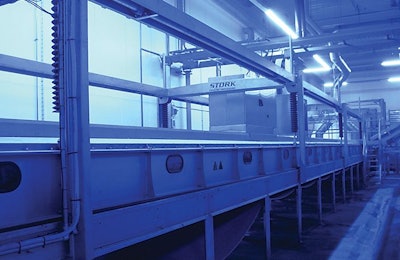
The majority of broilers in the U.S. are stunned by the use of electrical current, however, this may be changing.
Driven by a perceived animal welfare improvement, there is a movement toward controlled atmosphere stunning (CAS). There are certainly some animal welfare benefits to CAS, but there are drawbacks as well.
With controlled atmosphere stunning systems, broilers are irreversibly stunned prior to shackling. This eliminates animal welfare concerns during this step in the process. Irreversible stunning prior to shackling also benefits the hanging crew by providing a cleaner work environment with better lighting and easier hanging of a stunned or dead bird instead of a live one.
However, the stunning, from the start of the stun until unconsciousness, is not instantaneous and if any birds are not fully stunned recovery can occur very quickly. It is also more difficult to identify recently dead on arrival (DOA) birds.
The welfare argument often becomes whether the benefits of removing live shackling outweigh the increased length of time required to induce unconsciousness.
Types of controlled atmosphere stunning
There are several differing types of CAS systems available for broiler stunning. These include low atmospheric pressure stunning (LAPS) and gas stunning.
The low atmospheric pressure stunning system utilizes computer-controlled, slow decompression within large chambers. This system allows for the use of existing broiler containment modules (cages), does not require the continued purchase of gasses and is approved for use in the U.S.
There are a greater variety of gas stunning options available for use. Generally, these systems operate in a multi-phase process where gas concentrations increase gradually to first induce unconsciousness, then continue to completion at higher gas levels. The types of gases used can be carbon dioxide, nitrogen or argon, or a combination. Carbon dioxide is the most commonly used method. Additionally, higher levels of oxygen during the induction of unconsciousness can also be used.
Pit versus tunnel systems
There are several types of gas stunning systems to be considered. Pit systems function by the gradual lowering of drawers or cages into a pit containing gas. These pits are generally underground and allow for the greatest conservation of gases used for stunning. The lowering of the drawers into the pit allows for a gradual increase of gas concentrations during stunning as well as stunning without dumping.
Tunnel systems remain above ground and also allow for multi-phase stunning. In tunnel systems, birds can be stunned in the transport modules, in a single layer of drawers, or in a single layer of birds following unloading. These systems may require a larger footprint and a higher amount of gas per bird than a pit system but do not require the digging and sealing of a pit.
If traditional dump-type transport modules are used, either the entire module needs to enter the stunner or birds have to be unloaded prior to stunning, which can be a welfare concern. Otherwise, a shift to a drawer transport module system is needed.
Figure 1: Controlled atmosphere stunning system configurations

Three types of controlled atmosphere stunning systems can accommodate either drawer or dump transport modules and have variable levels of gas use.
If you are considering making the change from electrical to controlled atmosphere stunning, there are several things to consider:
- Cost of the system – including installation and maintenance
- Cost of gas and power
- Footprint necessary for the system
- Storage area for gas silos with truck access
- Dump-type transport module systems versus drawer transport module systems
- Inclusion of a back-up system (like an electrical stunner) to be used when necessary
- Benefits to employees
- Potential benefits of meat quality
- Customer demand for CAS
Cost considerations
CAS will cost more than electrical stunning initially. Some data indicates improved product quality over electrical stunning. However, these studies generally compare CAS to European electrical stunning, which uses a much higher current than the typical system in the U.S.
Suggestions exist that meat quality may be improved in the form of fewer broken wings, fewer breast fillet hemorrhages, and less leg damage. However, conflicting information also shows that wing damage is higher in CAS systems.
There is a lack of direct comparison between electrical stunning within U.S. parameters, CAS, and low atmosphere stunning systems. Variations in controlled atmosphere stunning system type and gas used can also affect end-product meat quality.
In 2012, the European Commission Directorate General for Heath and Consumers published a report comparing the cost of different poultry stunning methods which concluded CAS had the highest cost and electrical the lowest, with low atmosphere stunning in between. It is also important to note that the potential cost of replacing intake systems and transport modules were not considered.
While CAS was estimated to have a higher cost, there may potentially be increased revenue. CAS would allow access to certain markets based on customer requirements for specific animal welfare practices.
If you decide to make the switch to controlled atmosphere stunning, whichever system you choose, always be sure to have a backup plan such as an electrical water-bath stunner.
Figure 2: Estimation of the cost of stunning based on European Union calculations

The average cost per bird for CAS systems is higher than electrical stunning, but these costs may be offset through expanding available markets. Table adapted from European Commission Directorate General for Heath and Consumers report.

















